
Droitwich Spa is an historic spa town in the Wychavon district in northern Worcestershire, England, on the River Salwarpe. It is located approximately 22 miles (35 km) south-west of Birmingham and 7 miles (11 km) north-east of Worcester.

Lymington is a port town on the west bank of the Lymington River on the Solent, in the New Forest district of Hampshire, England. It faces Yarmouth, Isle of Wight, to which there is a car ferry service operated by Wightlink. It is within the civil parish of Lymington and Pennington. The town has a large tourist industry, based on proximity to the New Forest and its harbour. It is a major yachting centre with three marinas. As of 2015, the parish of Lymington and Pennington had a population of 15,726.
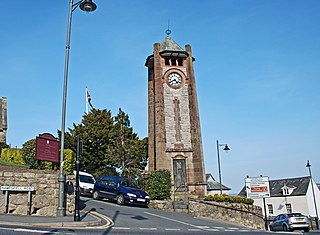
Grange-over-Sands is a town and civil parish located on the north side of Morecambe Bay in Cumbria, England, a few miles south of the Lake District National Park. In the 2001 census the parish had a population of 4,042, increasing at the 2011 census to 4,114. Historically part of Lancashire, the town was created as an urban district in 1894. Since the 1974 local government re-organisation, it has been of the South Lakeland district of Cumbria, though it remains part of the Duchy of Lancaster.

The Roman Baths are well-preserved thermae in the city of Bath, Somerset, England. A temple was constructed on the site between 60–70AD in the first few decades of Roman Britain. Its presence led to the development of the small Roman urban settlement known as Aquae Sulis around the site. The Roman baths—designed for public bathing—were used until the end of Roman rule in Britain in the 5th century AD. According to the Anglo-Saxon Chronicle, the original Roman baths were in ruins a century later. The area around the natural springs was redeveloped several times during the Early and Late Middle Ages.
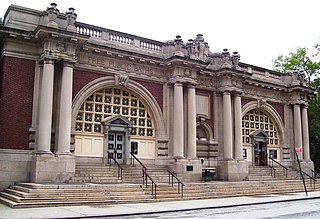
Public baths originated when most people in population centers did not have access to private bathing facilities. Though termed "public", they have often been restricted according to gender, religious affiliation, personal membership, and other criteria. In addition to their hygienic function, public baths have also been social meeting places. They have included saunas, massages, and other relaxation therapies, as are found in modern day spas. As the percentage of dwellings containing private bathrooms has increased in some societies, the need for public baths has diminished, and they are now almost exclusively used recreationally.

The Royal Pump Rooms is a cultural centre on the Parade in Leamington Spa, Warwickshire, England. It was the most famous of several spa baths opened in Leamington between the late-18th and mid-19th centuries. People would travel from throughout the country, and indeed Europe, to benefit from treatments using the town's healing waters. When 'taking the waters' became less fashionable after the mid-19th century the Pump Rooms became Leamington's only surviving spa facility, later also being extended to include the town's public swimming pool. After a major redevelopment in 1997-99 the building now houses Leamington Spa Art Gallery & Museum, a public library, a Tourist Information Centre, cafe and assembly rooms. It is a Grade II listed building.
Sidney Little, MICE (1885–1961) was a British civil engineer. He was born in Carlisle and after working in Ipswich as the Borough Engineer he was appointed in 1926 in Hastings, East Sussex as the Borough and Water Engineer, later including the role of Borough Planning Officer. He worked there for 24 years. During that time, he was responsible for implementing a number of major projects in the town.

The Lido, Bristol is an historic lido situated in Oakfield Place in the Whiteladies Road area of Clifton, Bristol, England. Originally opened in approximately 1850, the pool eventually fell into disrepair and was closed in 1990. Despite being considered for demolition, the building was given Grade II* listed building status in 1998. It was purchased by the Bristol Glass Boat Company who restored the pool, for its reopening in November 2008.

Tinside Lido is a 1935 Art Deco lido in the city of Plymouth in south-west England. It is sited beside Plymouth Sound and is overlooked by Plymouth Hoe and Smeaton's Tower. The lido is open in the summer months between May and September.

The Thames Lido, formerly known as the King's Meadow swimming pool, is an open-air swimming pool or lido located in King's Meadow in Reading, Berkshire. It was first opened to the public in 1903 as the Ladies Swimming Bath and is believed to be the oldest surviving outdoor municipal pool of a similar early Edwardian era. In August 2004, as a result of a campaign, the building was awarded Grade II listed building status. It re-opened in 2017 after three years of restoration.

Cleveland Pools located in Hampton Row, Bath, Somerset, England is a semi-circular lido built to designs by John Pinch the Elder in 1815. It is believed to be the oldest public outdoor swimming pool in England. It is a Grade II* listed building.
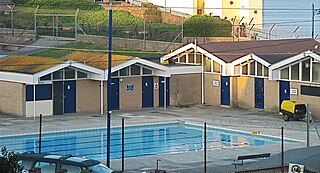
Teignmouth Lido is an open-air heated public lido at Eastcliff Walk, Teignmouth, Devon, England.

Pells Pool is a public outdoor swimming baths or lido in Lewes, East Sussex, England. The original structure was built in 1860 making it the oldest freshwater outdoor public swimming baths in the United Kingdom that is still operating.

The Caerleon Roman Fortress and Baths museum is a historical site located in the town of Caerleon, South Wales. Near to the city of Newport, it is run by the Welsh historic environment service Cadw.

Buckland Rings is the site of an Iron Age hill fort in the town of Lymington, Hampshire. Today, the mounds and dykes around the outside which once constituted its defences are still clearly visible, although the outer bank lies under the road on the west side, and on the south-east it is nearly ploughed-out. Excavations of the inner and middle ramparts in 1935 revealed that they were of wall-and-fill construction, retained at the front by upright timber beams and walls of cut and laid turf. The entrance, which lies on the east side, was also excavated revealing a long entrance passage and the postholes for a pair of stout gateposts. The site was bought by Hampshire County Council in 1989 to ensure its preservation, and it is open to the public from the A337 road onto which part of it faces.

The golden age of lidos in the United Kingdom was in the 1930s, when outdoor swimming became popular, and 169 were built across the UK as recreational facilities by local councils. Many lidos closed when foreign holidays became less expensive, but those that remain have a dedicated following.
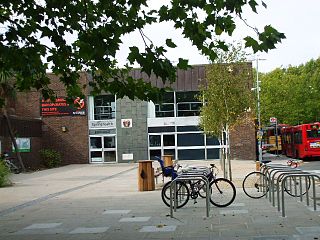
Pools on the Park is a Grade II listed swimming pool and leisure facility in Old Deer Park in Richmond, London. Construction on the 6.5-acre (2.6 ha) site started in 1964 and was completed in 1966; the architect was Leslie Gooday. The pool replaced the previous Richmond baths nearby which had been built in Parkshot in 1882.
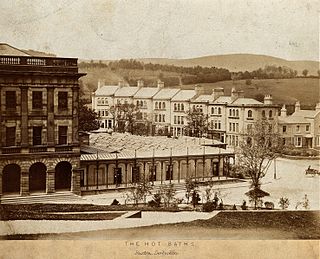
The Buxton Baths using natural thermal spring water are in Buxton, Derbyshire, England. The baths date back to Roman times and were the basis for developing Buxton as a Georgian and Victorian spa town. The present buildings of the Thermal Baths and the Natural Mineral Baths were opened in the 1850s. They are positioned either side of the Buxton Crescent at the foot of The Slopes in the town's Central Conservation Area. They are both Grade II listed buildings designed by Henry Currey, architect for the 7th Duke of Devonshire.

Jubilee Pool is an Art Deco lido in Penzance, Cornwall. It is Grade II listed, being recognised as the finest surviving example of its type with the exception of Saltdean Lido. With a capacity of 5 million litres and 600 swimmers and measuring 300 feet long and 160 feet wide, it is the UK's largest seawater pool.


















